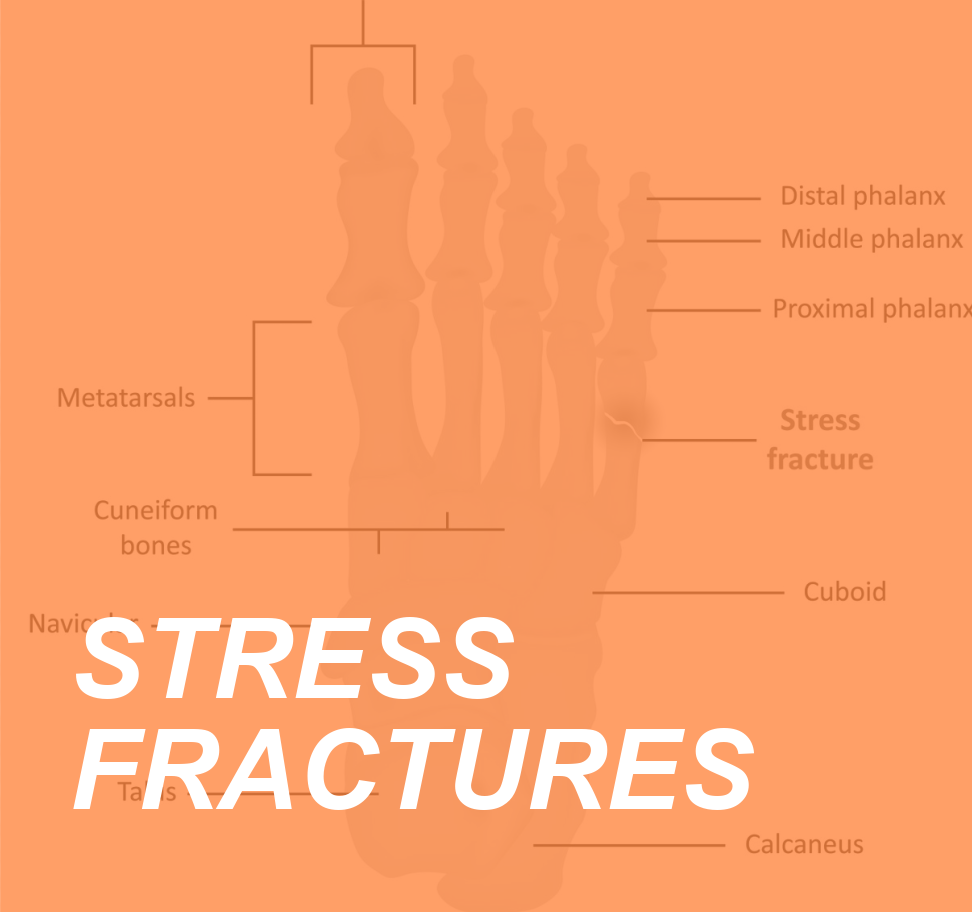If you’ve ever suffered a stress fracture, then you know that pain: the aching, often stabbing sensation in the shins, reminding us we overdid it on the trail running and high-impact aerobics, or our athletic shoes seriously need replacing. Seasoned athletes and recreational warriors alike can suffer from this injury. Read on to gain a better understanding of how we can help clients avoid suffering, both in terms of pain and mandatory rest time away from the gym.
Orthopedics 101
Stress fractures, indicative of small cracks in a bone, often occur following repetitive force and/or overuse — regular sessions of jumping, for example, or excessive frequency of cross-country running. Track and field athletes who specialize in events involving sprinting at high speeds or hurdle-jumping tend to fall prey to shin splints with alarming regularity, which are different from stress fractures but they share overlapping symptoms. Stress fractures also develop from everyday use if a bone already suffers from osteoporosis, or if an overzealous client dives into exercise too soon after having taken time off to nurse an injury.
Bone adapts gradually to increased loads through remodeling, a normal process involving osteoblasts and osteoclasts, the cells responsible for the breakdown and rebuilding of bone tissue. Any new, arduous or atypical force placed upon bone tissue, without allowing sufficient time for recovery, causes tissues to break down at a higher rate than that of replacement, rendering the tissue more susceptible to stress fractures.
Etiology and Symptoms of Stress Fractures
Whether on a treadmill or outdoor surfaces, the repetitive impact of running causes 20-75% of all stress fractures. These tend to occur in the tibia, located in the shin. Feet, too, suffer a disproportionate number of stress fractures, most commonly observed in the 2nd and 3rd metatarsal bones within the toes. Physicians sometimes see stress fractures in the hip, back, and even the heel.
The initial signs of an impending stress fracture seem consistent from individual to individual, and include the following ~
- Pain when bearing weight
- Swelling
- Tender when touched
- Persistent pain, even at rest or engaging in normal ADL
Diagnosing Stress Fractures
Several methods of scanning can reveal a stress fracture. The MRI (magnetic resonance imaging) seems most reliable, as it uses a magnetic field and computer-generated radio waves to produce highly-detailed images of affected tissue. Bone scans utilizing a radioactive tracer can prove helpful in diagnosing stress fractures; however, an X-ray only offers conclusive proof after the patient has dealt with pain for 3-4 weeks.
Risk Factors for Incurring Stress Fractures
While participation in higher-impact sports such as track/field, basketball, and gymnastics definitely may increase one’s chances of suffering a stress fracture, other risk factors do play a role. Moving too abruptly from a sedentary lifestyle to an arduous workout program, or increasing the intensity/frequency of one’s current training protocol, can also place undue stress on the bones.
Women seem to incur more stress fractures than men, particularly those individuals who experience irregular menstrual cycles. Women’s shoes, too, fashionably stylized with pointy toes and high heels, pose problems for feet. However, any ill-fitting footwear and athletic shoes can invite stress fractures. Runners often seek out shoes with ample room in the toe box, built-in stability, and side-rolling protection, for this very reason.
Any individual with weaker bones, either due to genetics, osteopenia, or a significant lack of nutritional calcium and Vitamin D in, can lead to problems. Young females who engage in eating-disordered behaviors, particularly consuming extremely little food, will naturally find themselves developing a weaker bone structure; couple this with intense physical activity, and stress fractures most likely will develop.
[sc name=”running” ][/sc]
NSAIDs and Bone Strength
Anecdotally, we know that clients often reach for non-steroidal anti-inflammatory drugs (NSAIDs) after a tough training session leaves them unusually sore. New evidence regarding the overuse of NSAIDs sheds an interesting light on stress fractures.
During weightlifting or any activity that places a significant load upon the body, an inherent adaptation leads to stronger bone formation. As trainers we always remind clients about the value of any weight-bearing exercise in holding osteoporosis at bay; scientists now feel this could actually help thwart a potential stress fracture in the area of the body experiencing the mechanical load. While more clinical trials on humans have yet to occur, animal studies suggest that overuse of NSAIDs may suppress this important adaptive response.
Potential Complications
Nobody likes to remain idle for too long, especially those accustomed to regular physical engagement. However, resuming one’s activity before an affected bone has fully recovered can delay the healing process as well as increase the risk for more serious and complete fractures. In such cases, an athlete may find himself sidelined for an even longer period of time.
Individuals, and athletes in particular, who fail to properly address a stress fracture or delay treatment run the risk of developing a condition known as avascular necrosis, or death of the bone tissue. This condition occurs due to a lack of adequate blood supply. Left untreated, avascular necrosis could pave the road to severe arthritis as the affected bone loses its former shape. Due to constant pain even at rest, or the individual’s ultimate inability to bear weight on the affected limb, we can see how this might spell the end of an athlete’s career or the termination of a client’s training abilities. Prudent athletic trainers, coaches, and personal trainers might advise their at-risk clients of all these pitfalls, while still keeping them on a satisfying exercise path.
References:
https://pubmed.ncbi.nlm.nih.gov/16907999/
https://pubmed.ncbi.nlm.nih.gov/33641442/
https://www.mayoclinic.org/diseases-conditions/stress-fractures/symptoms-causes/syc-20354057
https://www.mayoclinic.org/diseases-conditions/stress-fractures/diagnosis-treatment/drc-20354063
https://my.clevelandclinic.org/health/diseases/15841-stress-fractures
https://orthoinfo.aaos.org/en/diseases–conditions/stress-fractures-of-the-foot-and-ankle/
https://www.mayoclinic.org/diseases-conditions/avascular-necrosis/symptoms-causes/syc-20369859



